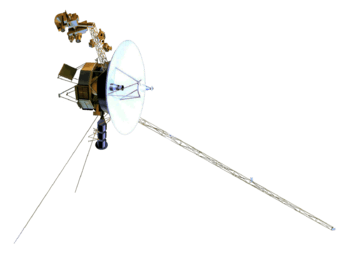Voyager 2 facts for kids

Model of the Voyager spacecraft design
|
|
| Mission type | Planetary exploration |
|---|---|
| Operator | NASA / JPL |
| Mission duration | 48 years, 4 months and 14 days elapsed Planetary mission: 12 years, 1 month, 12 days Interstellar mission: 36 years, 3 months and 1 day elapsed (continuing) |
| Spacecraft properties | |
| Manufacturer | Jet Propulsion Laboratory |
| Launch mass | 825.5 kilograms (1,820 lb) |
| Power | 470 watts (at launch) |
| Start of mission | |
| Launch date | August 20, 1977, 14:29:00 UTC |
| Rocket | Titan IIIE |
| Launch site | Cape Canaveral LC-41 |
| Flyby of Jupiter | |
| Closest approach | July 9, 1979, 22:29:00 UTC |
| Distance | 570,000 kilometers (350,000 mi) |
| Flyby of Saturn | |
| Closest approach | August 26, 1981, 03:24:05 UTC |
| Distance | 101,000 km (63,000 mi) |
| Flyby of Uranus | |
| Closest approach | January 24, 1986, 17:59:47 UTC |
| Distance | 81,500 km (50,600 mi) |
| Flyby of Neptune | |
| Closest approach | August 25, 1989, 03:56:36 UTC |
| Distance | 4,951 km (3,076 mi) |
|
Flagship
|
|
Voyager 2 is a special robotic spacecraft built by NASA. It was sent to explore the outer planets of our Solar System: Jupiter, Saturn, Uranus, and Neptune. It is the only spacecraft that has ever flown close to Uranus and Neptune. This means most of the amazing pictures we have of these two icy planets came from Voyager 2.
Voyager 2 is a twin to its sister ship, Voyager 1. Both spacecraft were launched in 1977. Voyager 2 began its journey on August 20, 1977. Today, it is still traveling far away from the Sun, heading out into the space between stars.
Contents
A Message to Aliens
Both Voyager 1 and Voyager 2 carry a special item called the Voyager Golden Record. This record is like a time capsule from Earth. It contains sounds and images that show what life on our planet is like. A team led by scientist Carl Sagan designed it. The idea was to send a message to any extraterrestrial life (aliens) that might find the spacecraft one day.
Leaving Our Solar System
In 2018, NASA announced exciting news. Voyager 2 had reached a place called the heliopause on November 5 of that year. The heliopause is the edge of the Sun's protective bubble of particles and magnetic fields. When Voyager 2 crossed this boundary, it officially entered interstellar space. This means it left the area influenced by our Sun and is now traveling through the vast space between stars.
Related Space Missions
Images for kids
-
This NASA map shows the paths of the Pioneer 10, Pioneer 11, Voyager 1, and Voyager 2 spacecraft through the solar system.
See also
 In Spanish: Voyager 2 para niños
In Spanish: Voyager 2 para niños








